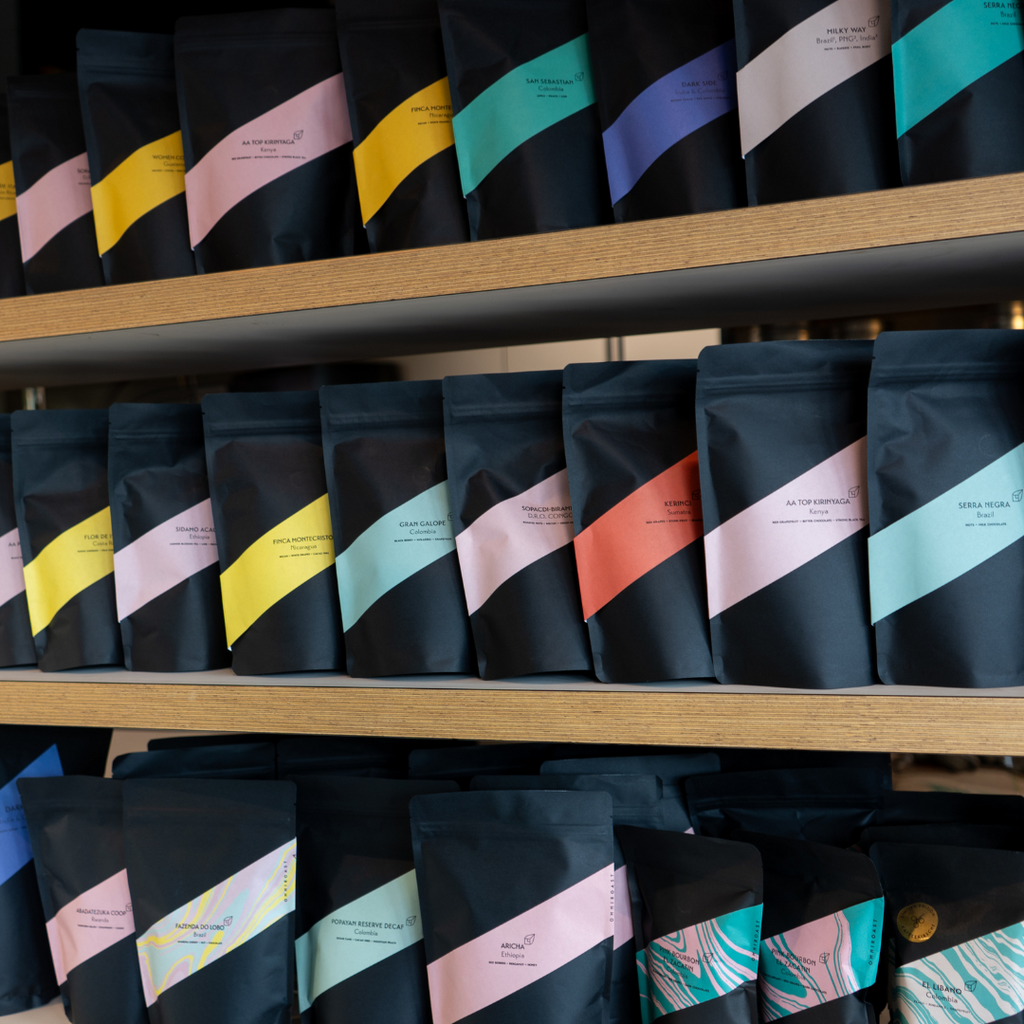Along the Coffee Belt – A Journey Through the World of the Coffee Cherry

Did you know that the bright colors of the stripes on our coffee packages have a meaning?
They represent the coffee regions along the so-called Coffee Belt. The Coffee Belt is the geographical region around the equator where most of the world's coffee is produced. From Brazil to Ethiopia via Southeast Asia, there are numerous coffee regions characterized by their specific growing conditions, techniques, and flavor profiles. Of course, not all coffee beans can be precisely assigned to a specific region, yet the coffee regions offer a flavor guide.

Africa, and particularly Ethiopia , is considered the birthplace of Arabica coffee. Ethiopia is Africa's largest coffee producer and is home to a wide variety of Arabica varieties, ranging from fruity to floral. Examples of this are varieties such as Sidamo and Yirgacheffe. A large proportion of the green coffee comes from small, privately run plantations that are organized locally in cooperative associations. Due to the intense drought in Ethiopia, the harvest must take place at a specific time to prevent the coffee cherries from drying out on the bushes. The coffee beans are processed using both dry and wet methods. Our Sidamo Acacia can be described as a typical Ethiopian coffee. Its tea-like character is emphasized by fruity-sweet aromas.
In Kenya , similar to Ethiopia, coffee is primarily cultivated by smallholder farmers organized in cooperatives. Kenyan coffee is often processed using wet processing and is known for its complex aromas and distinctive, fruity flavors. Due to the high-altitude growing areas, climatic conditions, sufficient rainfall, moderate temperatures, and mineral-rich soils, the coffee plants develop aromas similar to those of tea, especially black tea. The aroma of our AA Top Githima is reminiscent of black tea with a prominent acidity.

South American coffee often offers a balanced flavor profile characterized by nutty and chocolatey nuances as well as a mild acidity.
Thanks to the ideal conditions of equatorial, subtropical, and temperate climates , Brazil is the world's largest producer of coffee beans. Due to the vastness of the country, the varying locations and altitudes of the growing regions, climatic conditions, and the multitude of coffee varieties, Brazil also offers a very diverse range of coffee varieties. Nevertheless, Brazilian coffees are traditionally characterized by chocolate and nutty flavors. However, the quantity produced has its consequences: monoculture, degraded soils, and the use of pesticides. Furthermore, fluctuations or crises during the Brazilian harvest have a direct impact on the international market and coffee prices.
Colombia is also a major coffee producer in South America. Founder Turabi experienced it all firsthand on his coffee journey in the summer of 2022. The altitude, moderately warm temperatures, and mineral-rich volcanic soil provide ideal growing conditions for the exclusively cultivated Arabica plants. A traditional Colombian cup is known for its fruity, nutty, and cocoa nuances, pronounced sweetness, and balanced acidity. 
The coffee-growing regions in Central America begin in southern Mexico and end in southern Panama. Due to its volcanic origin, Central America offers fertile, mineral-rich soils for coffee cultivation.
Costa Rica is synonymous with high-quality Arabica beans that are carefully processed and controlled. The coffee plants thrive in the cool, mountainous regions and grow comparatively slowly. This gives the coffee beans the opportunity to develop a complex, distinctive profile. Costa Rican beans are characterized by this very complex structure and pleasant sweetness. The ripe coffee cherries are harvested exclusively by hand, while they are dried in the sun. Furthermore, the cultivation of Robusta beans is prohibited by law.
With its mild body, subtle acidity, and nutty, cocoa aromas, our Guatemalan coffee Women CODECH from Huehuetenango fits the bill perfectly for a Central American coffee. In Guatemala , with its diverse microclimates, landscapes rich in flora and fauna, and fertile, mineral-rich volcanic soils, coffee thrives with a mild flavor, distinctive aroma, and a slight sweetness. The predominantly Arabica beans are traditionally hand-picked and mostly wet-processed. 
The largest coffee producer in Asia is Vietnam . Robusta is traditionally grown in Vietnam. However, Arabica beans are also becoming increasingly common. Indonesia is well known for its Kopi Luwak coffee, i.e. coffee beans that are eaten, digested, and then excreted by a civet cat. These coffee beans are collected from nearby forests and processed and roasted there. The special enzymes of the digestive process affect the beans and are said to ensure an exceptional flavor. But beware of animal cruelty! Because the reality is different: the civet cats are stuffed with coffee beans in cages that are too small.
Indonesia has so much more to offer. Coffee is grown on many of the islands. Varying rainfall, altitudes, and humidity levels make the coffee so diverse.
Because water is scarce in some regions of Sumatra, coffee farmers often use the Giling Basah method, in which the coffee cherries are processed with a higher moisture content than with other processing methods.
---
Whether fruity, chocolatey, or nutty—each coffee region has its own unique character. And the best part? You can try them all! Come by, grab a cup, and sip your way around the world with us. We look forward to seeing you!
